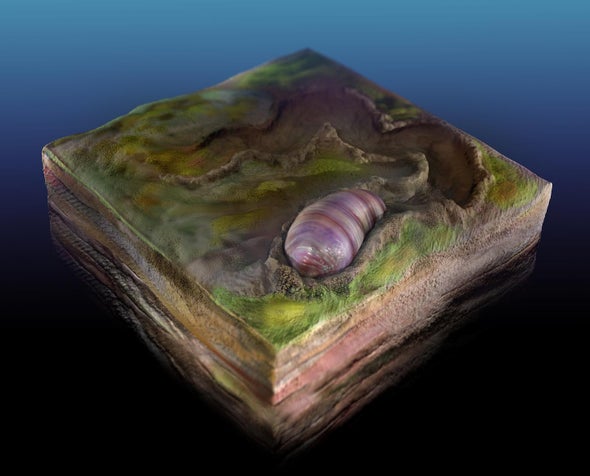(单词翻译:单击)
听力文本
This is Scientific American's 60-second Science, I'm Susanne Bard.
Half a billion years ago, there existed a wormlike creature the size of a grain of rice. And a new study finds that this animal may have been the first to crawl around the seafloor, gobble up organic matter at one end and poop it out the other end. The creature, dubbed Ikaria wariootia, was probably one of our oldest relatives.
"Ikaria is maybe the oldest bilaterian animal that we find in the fossil record. So this is twice as old or more than things like dinosaurs."
University of California, Riverside paleontologist Scott Evans. He says animals like sponges are even more ancient, but they lack the bilateral symmetry that characterizes most animals today.
"So a front and a back and a symmetrical left and right side. And bilaterians also have an opening for food to go in, an opening for waste to go out and a gut connecting them, basically a tube. And really, most animals, everything from insects to mammals to us, those are all bilaterians that are around today."
Evans and his colleagues discovered the humble creatures in fossil layers from the Ediacara Hills of South Australia. They used 3-D laser scanners from NASA to make high-resolution images of Ikaria and the surfaces they lived on. The scans confirmed the animals' bilateral body morphology and revealed the shape of the burrows they left from scavenging the seafloor.

"It probably had a body that was divided into what we refer to as modules, or units or segments. And because of the way it moved through the sediment, we think it had muscles and probably moved similar to how an earthworm moves by sort of extending and contracting its body using those muscle groups."
Later animals built off of Ikaria's basic body morphology—which featured a small front end and a larger rear end.
"It doesn't have a head or a tail, but it's starting that type of body organization by which things can build a head and a tail."
What's more, Ikaria had the ability to sense the environment around it.
"And sense where food was and where oxygen was, which is also a critical evolutionary step in these early animals."
The study is in the Proceedings of the National Academy of Sciences.
It might not seem like we share that much with a 555-million-year-old fossil, but looks can be deceiving. There's probably a little bit of Ikaria in all of us.
Thanks for listening for Scientific American's 60-second Science. I'm Susanne Bard.
参考译文
这里是科学美国人——60秒科学系列,我是苏珊娜·巴德。
5亿年前,生存着一种体型如米粒大小的蠕虫状生物。一项新研究发现,这种动物可能是第一种在海底爬行的动物,它们一端吞食有机物,然后从另一端排出来。这种生物名为Ikaria wariootia,可能是我们最古老的亲戚之一。
“Ikaria可能是我们在化石记录中发现的最古老的两侧对称动物。因此,其年龄是恐龙等动物的两倍或更多。”
加州大学河滨分校的古生物学家斯科特·埃文斯。他表示,海绵等动物更古老,但它们缺少现今大多数动物的两侧对称特性。
“前面和后面,左右两侧对称。两侧对称动物还有一个口用来进食,另一个口可以用于排泄废物,一根肠连接两口,基本上就像管子那样。实际上,从昆虫到哺乳动物再到我们人类,大多数动物都是两侧对称动物。”
埃文斯及其同事在南澳大利亚州埃迪卡拉山的化石层中发现了这种外形简陋的生物。他们用美国国家航空航天局(简称NASA)的3D激光扫描仪对Ikaria及其生存平面进行高分辨率成像。扫描确认了这些动物的两侧对称身体形态,并揭示了它们在海底觅食时留下的洞穴形状。
“它可能有一个身体被分成我们所说的所说的‘模块’,‘单位’或‘节’。根据它在沉积物中的移动方式,我们认为它拥有肌肉,可能像蚯蚓那样通过肌肉组伸缩身体来移动。”
后来的动物以Ikaria的基本身体形态来建造,形态特点是前端小,后端大。
“它没有头或尾巴,但它开始用能建造头和尾的东西来建造这种身体组织。”
此外,Ikaria有感知周围环境的能力。
“感知食物和氧气的位置,这也是这些早期动物进化的关键步骤。”
这项研究发表在《美国国家科学院院刊》上。
看起来我们与5.55亿年前的化石没有那么多共同点,但外表可能是骗人的。我们每个人身体中可能都有一点Ikaria。
谢谢大家收听科学美国人——60秒科学。我是苏珊娜·巴德。
译文为可可英语翻译,未经授权请勿转载!
重点讲解
重点讲解:
1. gobble up 贪婪地吃;狼吞虎咽;
There were dangerous beasts in the river that might gobble you up.
河里有吃人的危险动物。
2. divide into (使)分开;(使)分散;(使)分裂;
The physical benefits of exercise can be divided into three factors.
运动对身体的好处可以分为3个方面。
3. refer to 指;
Here it refers to elementary education, starting with simple reading and basic skills.
这里指的是从简单阅读和基本技能开始的基础教育。
4. what's more 更有甚者;更为重要的是;此外;
What's more, you'll be able to take home the copies of all the recipes.
另外,你还可以把所有食谱拷贝后带回家。


